
By definition a trailblazer is simply a “leader or pioneer in a particular field.” If you’ve studied the history of physical education you’ll be familiar with many of our original trailblazers. These professionals, who broke away from the European influences and created the American system of Physical Education included W.G. Anderson, J.B. Nash, Edward Hitchcock, Clark Hetherington, Luther H. Gulick and the authors of “The New Physical Education,” Thomas Wood and Rosiland Cassidy. This book reshaped Physical Education in 1927 and changed the profession from a medical orientation to a comprehensive, educational approach. These first Physical Education trailblazers pursued different paths and redirected the field to help meet the ever-changing societal demands of their time in history.
This article was originally published on April 1, 2014 : https://www.pheamerica.org/2014/physical-education-trailblazers-a-contemporary-look/
Interestingly, during the evolution of a trailblazer’s work these individuals are often criticized, overlooked, or ridiculed for their different perspectives or theories. A real trailblazer, however, possesses a special sense of conviction and purpose and the ability to persevere even when others have doubted their passion for change and innovation.
Over the past fifty years, six professionals have made unique contributions to the field of Physical Education. They’ve offered us educational alternatives, curriculum models, and impacted legislation to help shape our profession. Many other leaders, scholars and activists followed and helped add to and perpetuate our profession – but these six professionals seem to stand out as trailblazers, helping to carve out a new direction for a New Physical Education. Many younger professionals may not be aware of their impact on our field or how they paved the way for the future. So, read more about the contemporary trailblazers of Physical Education.
Julian U. Stein
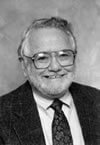
Considered by many experts as the father of Adapted Physical Education in the United States, Dr. Stein is a retired professor from George Mason University. For over 15 years he was the Executive Director for the Unit on Programs for the Handicapped for AAHPERD. His profound leadership lead to many changes in Washington D.C. and helped establish the foundation of how we all perceive children with challenges in Physical Education and Sport.
For many years experts felt that mentally challenged children were too weak to participate in sports such as basketball, softball, and volleyball. Stein changed that misconception by teaming up with the Kennedy Foundation and AAHPERD to help establish guidelines and books for physical education programs. In the mid 1960s, Stein edited the newsletter Challenge and published numerous papers and books with the help of the AAHPERD-Kennedy Program. His pioneering work in the 1960s provided children with opportunities to participate in recreation, sports, fitness and physical education. In the early-mid 1970s when the “inclusion movement” and new legislation was passed in Washington, Stein’s work was implemented and adapted Physical Education established a strong foothold in the curriculum.
Muska Mosston (1925-1994)
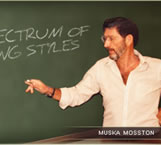
Muska Mosston viewed teaching Physical Education as more than merely skill drills, games and fitness routines. His passion was to observe children moving – identify their strengths and weaknesses, and then create a spectrum of developmental opportunities to help them discover themselves and enhance learning. He developed The Spectrum of Teaching Styles. These teaching styles were created to help teachers match teaching styles with a student’s learning needs, creating a series of decisions as the student moved through the developmental channels. The Spectrum offered physical educators alternatives of teaching along a continuum from command or direct styles of teaching to discovery approaches – giving more decision-making and freedom to the student.
This was an unpopular approach in the 1960s, since Physical Education at that time was built around control, structure, and very direct teaching strategies. In the early stages there was little research to support Mosston’s theories. Although the Spectrum was initially met with resistance, years later physical educators began embracing the opportunities it provided. Furthermore, the Spectrum helped to begin the debate about student learning and the methods used in physical education to accomplish desired learning outcomes. His book Teaching Physical Education (written with Sara Ashworth) is still used in many teacher education programs throughout the world.
Charles “Chuck” Corbin
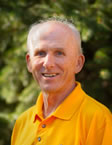
Charles “Chuck” Corbin is Professor Emeritus in the Department of Exercise and Wellness at Arizona State University. He has been recognized as the “father” of the Concepts approach to fitness education. His beginning work focused on exercise science, but by the late 1960s he saw the need for a college-level book related to the concepts of fitness. The notion was that students needed to understand the principles of exercise if they were going to engage in a lifelong commitment of physical activity.
Corbin’s book, Fitness for Life became the most widely used college text for basic fitness instruction by the mid1970s and remains a top seller today. Corbin felt that high school physical educators should also incorporate fitness concepts into their curriculums. He proposes a combination of both classroom and gymnasium based activity sessions. The activity sessions (at times serving as labs) were closely linked to the classroom content. Later, his model would include goal-setting, stress management, self-assessment strategies and how to be an informed consumer of fitness related products and developmentally appropriate exercises.
Corbin expanded the Fitness for Life model to include curriculum resources for teachers to use in high schools, middle schools, and now elementary schools. In the mid 1960s when it was commonplace for physical educators to merely have students run, perform pull-ups, sit-ups, and lift weights, Corbin felt that students not only needed to learn what they were doing-but why. He created a system for translating sophisticated exercise science language into understandable fitness concepts that students could use to help them develop a lifetime of physical activity and healthy lifestyles.
Corbin is the recipient of numerous awards and honors, including the Gulick Award, the highest honor bestowed by AAHPERD. His trailblazing efforts changed the way fitness has been taught in colleges and public schools throughout the nation.
Daryl Siedentop
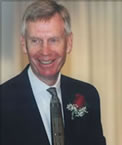
Daryl Siedentop is a professor emeritus of Sport and Exercise Science at the Ohio State University. He also served as Senior Associate Dean and Interim Dean of OSU’s College of Education. Siedentop is a prolific author of many books, papers, and research studies. He has also received numerous awards including the International Olympic Committee President’s Prize.
In the late 1970s – 1980s, Siedentop developed an observation system that reported the amount of time on task in which children were engaged in physical activity during a typical physical education class. The Academic Learning Time – Physical Education (ALT-PE) system was widely researched and brought new light to critical questions concerning class management and pedagogical choices when teaching Physical Education. A vast amount of research using this instrument has helped add to the content knowledge of pedagogy in Physical Education.
Daryl Siedentop is best known however, as the “father” of Sport Education. This well-known model was created in the early 1990s as a way to help students learn and enjoy various sports and related activities in a quality Physical Education program. Within this model, sport, dance, and fitness activities are organized into seasons where balanced teams compete, and students are given various roles and responsibilities such as referees, coach, manager, publicist, statistician, and others. The model has been very successful over the last 20 years since it incorporates a number of personal and social skills as well as a strong knowledge component, allowing students to assume responsibility for their own sport involvement. Although Sport Education has been successfully used at all grade levels, it has been credited with reviving a failing secondary Physical Education curriculum which was previously based on team and individual sports, athletic performance, and competition as the central focus.
Siedentop’s book on Sport Education quickly became a best seller, helping teachers to reinvent their physical education curriculum, as well as motivating students to learn and better appreciate sport. The Sport Education model has had a profound impact on the Physical Education curriculum and continues to be used throughout the world.
Don Hellison
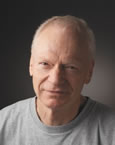
Don Hellison is considered the “father” of humanistic Physical Education. For many years he served as a Professor at Portland State and the University of Illinois – Chicago. Hellison has received the International Olympic Committee’s President Prize and the Gulick Award (AAHPERD’s highest honor). In the late 1960s into the 1970s humanistic education became a popular theme throughout all subject matter in schools. During this movement, the focus on students’ personal and social skills became as important, if not more important than a student’s academic achievements.
Responding to this trend, Hellison developed the Teaching for Personal and Social Responsibility model (TPSR) designed to help at-risk students better cope with the complexities of life. His model was centered on promoting self-control, responsibility, and creating a sense of self in students through physical education and sport related activities.
In the 1970s Hellison’s theories and views were often challenged by researchers at conferences because they appeared to lack scientific evidence. Hellison persevered and expanded his model to include levels of responsibility, along with practical applications that physical educators could use in the gymnasium. The TPSR model was also well tested and studies began to show positive results.
By the early 1990s, urban schools throughout the world were using the TPSR model in their physical education programs to cope with major social issues such as vandalism, teen pregnancy, drug use, and escalating dropout rates. Teachers throughout the world are now using the model to infuse social values, cooperation, and responsibility in their classes throughout the school year in combination with skills, fitness, and healthy lifestyle outcomes.
For over 40 years, Don Hellison has been committed to developing a model focused on teaching life skills and values through physical activity. Hellison truly epitomizes the spirit, energy, and conviction of a trailblazer. Today, his work continues to have a significant impact on the field of Physical Education.
George Graham
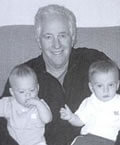
George Graham was a Professor on the faculty at Pennsylvania State University, and earlier at Virginia Tech for 17 years. In 2007, Graham was inducted into the NASPE Hall of Fame. Graham is best known for his work in the development of the Skill Themes Model focused on teaching elementary school aged children.
Strongly influenced by the work of Rudolph Laban, and American physical educator Kate Barrett, Graham has helped to reform the way elementary physical education is taught in schools in the US and around the world. The skill themes approach became a foundation for many elementary physical education curriculums. The model centered on locomotor, non-manipulative, and manipulative motor skills. Within the process of acquiring motor skills, children learned how to integrate movement concepts such as space, direction, levels, and extensions into different movement forms. The notion was that these fundamental movement skills were necessary building blocks for more advanced skills as children transitioned into middle school. Also, Graham formalized a process for teaching skills to students by developing four generic levels of skill proficiency (pre-control, control, utilization, and proficiency). He is also best noted for his work with NASPE as a co-author of the Developmentally Appropriate Practices document.
In the late 1960s and early 1970s when it was popular to base elementary level physical education instruction on a “games curriculum” – Graham led the charge for a developmental movement approach and designed a curriculum of movement concepts and movement themes that to date has stood the test of time and is used today worldwide. In 1996, Graham spearheaded the first educational website for physical education in the United States – PE Central. The site has received numerous awards and is widely used today.
George Graham is the author of numerous books and papers, however, his text Children Moving is widely used in university teacher education programs for preparing elementary physical educators.
Summary
So, where will the next generation of trailblazers come from? What kinds of innovations will we see in technology, new curriculum models, and legislative changes for healthier children? Will the changes occur within the U.S.or will the trailblazers come from other countries? In any event, the future of our profession will rely on the creativity, passion and convictions of professionals with the courage to meet societal demands in the name of healthy children. Trailblazers are unique. They are educational contrarians with a purpose and vision to make changes because “change was needed.” Their leadership will be marked in history and their impact on the physical development of children will be realized for many generations.
References
Corbin, C.B. , Welk, G., Corbin, W., & Welk, K. (2011). Concepts of physical fitness. New York, NY: McGraw Hill.
Graham, G., Holt-Hale, S., & Parker, M. (2010). Children moving (9thed.). New York, NY: McGraw Hill.
Hellison, D. (2011). Teaching personal and social responsibility through physical activity (3rded.). Champaign, IL: Human Kinetics.
Mosston, M. & Ashworth, S. (2002). Teaching physical education (5thed.). San Francisco: Benjamin Cummings.
Siedentop, D., Hastie, P., & VanDerMars, H. (2011). Complete guide to sport education (2nd ed.). Champaign, IL: Human Kinetics.
